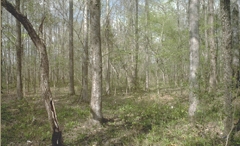- Yuchi Town Site
Infobox_nrhp | name =Yuchi Town Site
nrhp_type = nhl

caption = The site today.
location=Russell County, Alabama ,United States
locmapin = Alabama
lat_degrees = 32 | lat_minutes = 18 | lat_direction = N
long_degrees = 84 | long_minutes = 59 | long_direction = W
area =
built =1650
architect=
architecture=
designated=June 19 ,1996
added =June 19 ,1996 cite web |url=http://www.nr.nps.gov/ |title=National Register Information System|date=2007-01-23 |work=National Register of Historic Places |publisher=National Park Service]
governing_body = Department of the Army
refnum=95000453Yuchi Town Site, or Yuchi Town, is a late prehistoric and historic era
archaeological site showing occupation of both theApalachicola and ofYuchi tribes. The site is located in a remote area ofFort Benning , Russell County,Alabama . The Yuchi Town Site is an example of historic Native American cultures adopting various strategies to maintain their cultural integrity in the face of European colonization and the expansion of theUnited States .cite web|title="Yuchi Town Site"|work="National Historic Landmarks Program"|url=http://tps.cr.nps.gov/nhl/detail.cfm?ResourceId=1&ResourceType=Site|accessdate=2008-03-01] It was declared aNational Historic Landmark in 1996.citation|title=PDFlink| [https://www.denix.osd.mil/portal/page/portal/content/environment/CR/NRHPNHL/NHLMap/Alabama/YUCHI_TOWN_SITE_GA.PDF National Historic Landmark Nomination: Yuchi Town Site] |32 KB|date=September 29, 1993 |author=Braley, Chad O. and Mark R. Barnes |publisher=National Park Service]History
The site was initially an Apalachicola village, indicated by graves, aboriginal
pottery , trade beads, and other items. This phase of occupation is believed to date from A.D. 1650-1715, a time when Spanish influence in the region was present. At this time the Spanish established a short-lived mission at the village of Sabacola and maintained a garrison of troops at the town of Apalachicola. The Apalachicola allied with the Spanish in Florida during the 17th century against the English in theCarolinas and were ultimately destroyed as a culture.The next phase of occupation was by the Yuchi and would continue until their removal to
Oklahoma in 1836. The Yuchi constantly shifted their alliances with various European powers. They had occupied theSavannah River valley until they were defeated by theCherokee in 1681, then theOcmulgee River valley until 1716. After this they occupied the area surrounding theChattahoochee River and this is when they founded Yuchi Town. It is the largest known historic village site associated with the Yuchi. They were ultimately displaced by the expanding frontier of the United States.ee also
*
List of National Historic Landmarks in Alabama References
Wikimedia Foundation. 2010.
